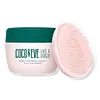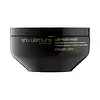What's inside
What's inside
 Key Ingredients
Key Ingredients

 Benefits
Benefits

 Concerns
Concerns

 Ingredients Side-by-side
Ingredients Side-by-side

Water
Skin ConditioningCetearyl Alcohol
EmollientCocos Nucifera Fruit Extract
EmollientDimethicone
EmollientBehentrimonium Chloride
PreservativeParfum
MaskingGlycerin
HumectantCetyl Alcohol
EmollientSodium Benzoate
MaskingFicus Carica Fruit Extract
HumectantArgania Spinosa Kernel Oil
EmollientShea Butter Ethyl Esters
EmollientCaryocar Brasiliense Fruit Oil
Skin ConditioningRicinus Communis Seed Oil
MaskingHydrolyzed Linseed Extract
Skin ConditioningLeuconostoc/Radish Root Ferment Filtrate
AntimicrobialPhenoxyethanol
PreservativeCetrimonium Chloride
AntimicrobialPotassium Sorbate
PreservativeEthylhexylglycerin
Skin ConditioningSelaginella Lepidophylla Extract
EmollientSaccharomyces/Silicon Ferment
Skin ConditioningSaccharomyces/Iron Ferment
Skin ConditioningSaccharomyces/Magnesium Ferment
Saccharomyces/Copper Ferment
Skin ConditioningSaccharomyces/Zinc Ferment
Skin ConditioningTocopherol
AntioxidantLactobacillus Ferment
Skin ConditioningBenzyl Alcohol
PerfumingBenzyl Salicylate
PerfumingCoumarin
PerfumingLimonene
PerfumingLinalool
PerfumingWater, Cetearyl Alcohol, Cocos Nucifera Fruit Extract, Dimethicone, Behentrimonium Chloride, Parfum, Glycerin, Cetyl Alcohol, Sodium Benzoate, Ficus Carica Fruit Extract, Argania Spinosa Kernel Oil, Shea Butter Ethyl Esters, Caryocar Brasiliense Fruit Oil, Ricinus Communis Seed Oil, Hydrolyzed Linseed Extract, Leuconostoc/Radish Root Ferment Filtrate, Phenoxyethanol, Cetrimonium Chloride, Potassium Sorbate, Ethylhexylglycerin, Selaginella Lepidophylla Extract, Saccharomyces/Silicon Ferment, Saccharomyces/Iron Ferment, Saccharomyces/Magnesium Ferment, Saccharomyces/Copper Ferment, Saccharomyces/Zinc Ferment, Tocopherol, Lactobacillus Ferment, Benzyl Alcohol, Benzyl Salicylate, Coumarin, Limonene, Linalool
Water
Skin ConditioningStearyl Alcohol
EmollientDimethicone
EmollientBehentrimonium Chloride
PreservativeGlycerin
HumectantAmodimethicone
Cetyl Esters
EmollientTocopherol
AntioxidantHydrolyzed Rice Extract
Skin ConditioningSodium Citrate
BufferingPhenoxyethanol
PreservativeAcetic Acid
BufferingSafflower Glucoside
Trideceth-15
EmulsifyingTrideceth-3
EmulsifyingChlorhexidine Digluconate
AntimicrobialLimonene
PerfumingBenzyl Alcohol
PerfumingBenzyl Salicylate
PerfumingLinalool
PerfumingIsopropyl Alcohol
SolventOleamide
2-Oleamido-1,3-Octadecanediol
Skin ConditioningCaprylyl Glycol
EmollientParaffinum Liquidum
EmollientCetrimonium Chloride
AntimicrobialCitric Acid
BufferingButylene Glycol
HumectantBHT
AntioxidantParfum
MaskingWater, Stearyl Alcohol, Dimethicone, Behentrimonium Chloride, Glycerin, Amodimethicone, Cetyl Esters, Tocopherol, Hydrolyzed Rice Extract, Sodium Citrate, Phenoxyethanol, Acetic Acid, Safflower Glucoside, Trideceth-15, Trideceth-3, Chlorhexidine Digluconate, Limonene, Benzyl Alcohol, Benzyl Salicylate, Linalool, Isopropyl Alcohol, Oleamide, 2-Oleamido-1,3-Octadecanediol, Caprylyl Glycol, Paraffinum Liquidum, Cetrimonium Chloride, Citric Acid, Butylene Glycol, BHT, Parfum
Ingredients Explained
These ingredients are found in both products.
Ingredients higher up in an ingredient list are typically present in a larger amount.
This ingredient is a preservative and often used for it's anti-static properties. You'll most likely see this ingredient in hair conditioners.
It does not cause irritation or sensitization in leave-on products at 1-5%.
Benzyl Alcohol is most commonly used as a preservative. It also has a subtle, sweet smell. Small amounts of Benzyl Alcohol is not irritating and safe to use in skincare products. Most Benzyl Alcohol is derived from fruits such as apricots.
Benzyl Alcohol has both antibacterial and antioxidant properties. These properties help lengthen the shelf life of products. Benzyl Alcohol is a solvent and helps dissolve other ingredients. It can also improve the texture and spreadability.
Alcohol comes in many different forms. Different types of alcohol will have different effects on skin. This ingredient is an astringent alcohol.
Using high concentrations of these alcohols are drying on the skin. They may strip away your skin's natural oils and even damage your skin barrier. Astringent alcohols may also irritate skin.
Other types of astringent alcohols include:
According to the National Rosacea Society based in the US, you should be mindful of products with these alcohols in the top half of ingredients.
Any type of sanitizing product will have high amounts of alcohol to help kill bacteria and viruses.
Learn more about Benzyl AlcoholBenzyl Salicylate is a solvent and fragrance additive. It is an ester of benzyl alcohol and salicylic acid. This ingredient can be naturally found in some plants and plant extracts.
In fragrances, Benzyl Salicylate may be a solvent or a fragrance component. In synthetic musk scents, it is used as a solvent. For floral fragrances such as lilac and jasmine, it is used as a fragrance component. The natural scent of Benzyl Salicylate is described as "lightly-sweet, slightly balsamic".
While Benzyl Salicylate has been associated with contact dermatitis and allergies, emerging studies show it may not be caused by this ingredient alone.
However, this ingredient is often used with fragrances and other components that may cause allergies. It is still listed as a known allergen in the EU. We recommend speaking with a professional if you have concerns.
Another study from 2021 shows Benzyl Salicylate may have anti-inflammatory properties.
Learn more about Benzyl SalicylateThis ingredient is a preservative, antimicrobial, and emulsifier. It is often used in cosmetics for its ability to cleanse, condition, and reduce static.
Cetrimonium chloride is a quaternary ammonium salt, meaning it has a water-soluble structure.
Dimethicone is a type of synthetic silicone created from natural materials such as quartz.
What it does:
Dimethicone comes in different viscosities:
Depending on the viscosity, dimethicone has different properties.
Ingredients lists don't always show which type is used, so we recommend reaching out to the brand if you have questions about the viscosity.
This ingredient is unlikely to cause irritation because it does not get absorbed into skin. However, people with silicone allergies should be careful about using this ingredient.
Note: Dimethicone may contribute to pilling. This is because it is not oil or water soluble, so pilling may occur when layered with products. When mixed with heavy oils in a formula, the outcome is also quite greasy.
Learn more about DimethiconeGlycerin is already naturally found in your skin. It helps moisturize and protect your skin.
A study from 2016 found glycerin to be more effective as a humectant than AHAs and hyaluronic acid.
As a humectant, it helps the skin stay hydrated by pulling moisture to your skin. The low molecular weight of glycerin allows it to pull moisture into the deeper layers of your skin.
Hydrated skin improves your skin barrier; Your skin barrier helps protect against irritants and bacteria.
Glycerin has also been found to have antimicrobial and antiviral properties. Due to these properties, glycerin is often used in wound and burn treatments.
In cosmetics, glycerin is usually derived from plants such as soybean or palm. However, it can also be sourced from animals, such as tallow or animal fat.
This ingredient is organic, colorless, odorless, and non-toxic.
Glycerin is the name for this ingredient in American English. British English uses Glycerol/Glycerine.
Learn more about GlycerinLimonene is a fragrance that adds scent and taste to a formulation.
It's found in the peel oil of citrus fruits and other plants such as lavender and eucalyptus. The scent of limonene is generally described as "sweet citrus".
Limonene acts as an antioxidant, meaning it helps neutralize free radicals.
When exposed to air, oxidized limonene may sensitize the skin. Because of this, limonene is often avoided by people with sensitive skin.
The term 'fragrance' is not regulated in many countries. In many cases, it is up to the brand to define this term. For instance, many brands choose to label themselves as "fragrance-free" because they are not using synthetic fragrances. However, their products may still contain ingredients such as essential oils that are considered a fragrance.
Learn more about LimoneneLinalool is a fragrance and helps add scent to products. It's derived from common plants such as cinnamon, mint, citrus, and lavender.
Like Limonene, this ingredient oxidizes when exposed to air. Oxidized linalool can cause allergies and skin sensitivity.
This ingredient has a scent that is floral, spicy tropical, and citrus-like.
Learn more about LinaloolParfum is a catch-all term for an ingredient or more that is used to give a scent to products.
Also called "fragrance", this ingredient can be a blend of hundreds of chemicals or plant oils. This means every product with "fragrance" or "parfum" in the ingredients list is a different mixture.
For instance, Habanolide is a proprietary trade name for a specific aroma chemical. When used as a fragrance ingredient in cosmetics, most aroma chemicals fall under the broad labeling category of “FRAGRANCE” or “PARFUM” according to EU and US regulations.
The term 'parfum' or 'fragrance' is not regulated in many countries. In many cases, it is up to the brand to define this term.
For instance, many brands choose to label themselves as "fragrance-free" because they are not using synthetic fragrances. However, their products may still contain ingredients such as essential oils that are considered a fragrance by INCI standards.
One example is Calendula flower extract. Calendula is an essential oil that still imparts a scent or 'fragrance'.
Depending on the blend, the ingredients in the mixture can cause allergies and sensitivities on the skin. Some ingredients that are known EU allergens include linalool and citronellol.
Parfum can also be used to mask or cover an unpleasant scent.
The bottom line is: not all fragrances/parfum/ingredients are created equally. If you are worried about fragrances, we recommend taking a closer look at an ingredient. And of course, we always recommend speaking with a professional.
Learn more about ParfumPhenoxyethanol is a preservative that has germicide, antimicrobial, and aromatic properties. Studies show that phenoxyethanol can prevent microbial growth. By itself, it has a scent that is similar to that of a rose.
It's often used in formulations along with Caprylyl Glycol to preserve the shelf life of products.
Tocopherol (also known as Vitamin E) is a common antioxidant used to help protect the skin from free-radicals and strengthen the skin barrier. It's also fat soluble - this means our skin is great at absorbing it.
Vitamin E also helps keep your natural skin lipids healthy. Your lipid skin barrier naturally consists of lipids, ceramides, and fatty acids. Vitamin E offers extra protection for your skin’s lipid barrier, keeping your skin healthy and nourished.
Another benefit is a bit of UV protection. Vitamin E helps reduce the damage caused by UVB rays. (It should not replace your sunscreen). Combining it with Vitamin C can decrease sunburned cells and hyperpigmentation after UV exposure.
You might have noticed Vitamin E + C often paired together. This is because it is great at stabilizing Vitamin C. Using the two together helps increase the effectiveness of both ingredients.
There are often claims that Vitamin E can reduce/prevent scarring, but these claims haven't been confirmed by scientific research.
Learn more about TocopherolWater. It's the most common cosmetic ingredient of all. You'll usually see it at the top of ingredient lists, meaning that it makes up the largest part of the product.
So why is it so popular? Water most often acts as a solvent - this means that it helps dissolve other ingredients into the formulation.
You'll also recognize water as that liquid we all need to stay alive. If you see this, drink a glass of water. Stay hydrated!
Learn more about Water